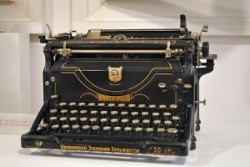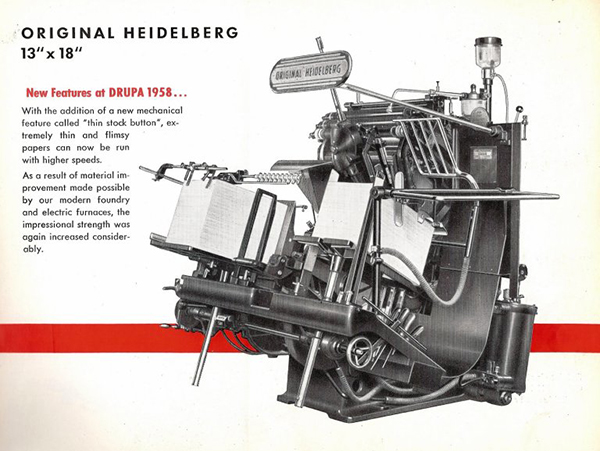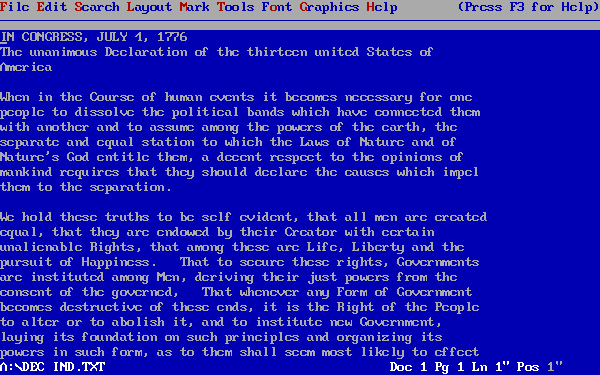The return of markup languages
When I first started my career as a technical writing in 1994 using WYSIWYG tools such as WordPerfect and FrameMaker, I thought I could never return to writing without the crutch of a stylesheet. I needed that beautiful layout those tools gave me to give me the illusion I was writing amazing words and paragraphs leading to the heights upon which Hemingway and Faulkner achieved. If I had stripped away the spellchecking tools, the auto-formatting, the Letter/A4 layouts and stuff those tools provided, I didn’t have much left. My words would have floundered upon the barren beach of poor wordsmithing. It was like putting on an ill-fitted suit and thinking I was dressed like a fine London gentleman or New York socialite. How wrong I was.
Form AND function seemed to be sit side by side in my brain. I couldn’t imaging one without the other. Layout AND content had to be seen at the same time. I couldn’t write without first making those words look pretty. As it turns out a word exists for it - beautification.
I am glad how innovation has come to the point that all that auto-beautification is basically pointless. I have discovered the joy of plain text. I’ve managed to walk without the crutch and is is fun.
Let me explain.
The pen
There once was a time when writing consisted of the ancient art of grasping a device filled with a coloured liquid and carefully sliding this tool across fields of white paper in a artistic way to form shapes and symbols. Surprisingly, if done with even rudimentary skills other people could look at the results and be filled with dread, amusement, surprise or advice depending on the choice of forms and symbols used and in which order. The person holding manipulating this device across the paper was known as a writer and the person deciphering those forms and symbols called words was known as a reader.
The art consisted of a few simple rules. Starting a short distance from the top left or top right of the paper, a writer would start writing those forms and symbols which are known as text. when sufficient space was absorbed by the text, the writer would continue a new line just below the last. And on it would go until the space in the paper was exhausted. This would continue until the writer had completed all that was needed.
Some wrinkles (not in the paper but in the art) included an ability to think ahead before writing, or at least while writing. You really saw what you got. If you messed up, you had to start again or write the correction is small text to the side of what was messed up. Usually this resulted in a clutter of crunched paper below the desk of the dedicated writer.
This was how writing was done for thousands of years until a great innovation took the world by storm.
The Typewriter
Someone or most probably many people invented a complex machine was used to generate printed documents. It had a mechanism for pressing a limited selection of letters onto a single sheet of paper. It was called a Typewriter. The Italians claim they invented it. The British claim they invented it and I am sure the Germans claim they invented it. National rivalries seem to get in the way with finding out the origins of modern technological innovations and the origin of the typewriter is no exception. Nevertheless, a group of Americans made the first commercially successful typewriter in Milwaukee, Wisconsin which was eventually sold as the Remington Sholes and Glidden Type-Writer. It had the QWERTY keyboard, the keyboard we all know and love today.
 Over time, by continuous use a typists (as users of this device were called) could achieve speeds in typing out sheets of paper such as 60 words per minute. An entire profession was built around specialists who had an ability to copy hand written text into a typed form at breakneck speed. Entire halls were filled with such professionals and the clatter of the keyboards and the ringing of the EOL (end of line) indicator bells made for a very loud working environment.
Over time, by continuous use a typists (as users of this device were called) could achieve speeds in typing out sheets of paper such as 60 words per minute. An entire profession was built around specialists who had an ability to copy hand written text into a typed form at breakneck speed. Entire halls were filled with such professionals and the clatter of the keyboards and the ringing of the EOL (end of line) indicator bells made for a very loud working environment.
In fact, these professionals were so fast they could damage the delicate mechanisms within the typewriter. To slow their typing speeds down and prevent damage, keyboard had this odd arrangement of keys which we referred to earlier as the QWERTY keyboard. This stands for the first six letters on the second row of keys. This layout has not changed and is still widely used throughout the English speaking world today.
With a typewriter, it was considered good form to use two spaces between sentences for readability. And the typewriter had just one font which was originally was a mono-spaced font within a fixed block or area. This font was hard-coded onto the faces of the keys. With electric typewriters, such as IBMs Selectric Typewriter, fonts could be changed by switching in and out a font ball which spun to the appropriate letter based on which key was selected.
But let’s not get ahead of ourselves.
Enter page layout
Layout is the arrangement of words, symbols and pictures on a page. Typewritten and hand-written documents have their own layouts which are constrained by their technology. A hand written document has its own unique layout such as white space however narrow or wide on the left and right of the text flow. Sometimes a writer could include elaborate artwork such as scribblings or drawings along the margins of the text and so forth. Typewriters added a uniform left and right margin as well as top and bottom margins. These could be set by an invention called a Tab Stop. Rolling the paper would create a top margin while the bottom margin was limited by the typewriter’s capability to hold the paper in the platen (the roll inside the device).
 The printing press had, of course, been available for hundreds of years and much of our layout terminology comes from this technology. During the early 1970s, I lived in Lancaster, Pennsylvania and worked as a printer operating an Heidelberg Platen Press.
in a printing company based in Lancaster, Pennsylvania. It was complicated to use and I had concentrating on its operation 100% of the time and know and understand the quirks of the press. But I loved running it. I got a thrill out of seeing this machine do its wonder. I can still hear the sound of the press picking up the paper, placing it on the platen then pressing the text onto the paper. To me, it was music. I enjoyed receiving the formed page from the typesetter and loading the type into the clamps to secure it for printing. I knew how much paper to load and when it was ready for more paper during a press run. But a press was not for personal use. It required users to bring in complete works to the print shop to be prepared for printing. Proofs which were quick first runs were handed to the customer for review. The customer would then add edit marks for the typesetter or in worst cases rewrite the entire document for submission to the typesetter.
The printing press had, of course, been available for hundreds of years and much of our layout terminology comes from this technology. During the early 1970s, I lived in Lancaster, Pennsylvania and worked as a printer operating an Heidelberg Platen Press.
in a printing company based in Lancaster, Pennsylvania. It was complicated to use and I had concentrating on its operation 100% of the time and know and understand the quirks of the press. But I loved running it. I got a thrill out of seeing this machine do its wonder. I can still hear the sound of the press picking up the paper, placing it on the platen then pressing the text onto the paper. To me, it was music. I enjoyed receiving the formed page from the typesetter and loading the type into the clamps to secure it for printing. I knew how much paper to load and when it was ready for more paper during a press run. But a press was not for personal use. It required users to bring in complete works to the print shop to be prepared for printing. Proofs which were quick first runs were handed to the customer for review. The customer would then add edit marks for the typesetter or in worst cases rewrite the entire document for submission to the typesetter.
Processing words
 With the introduction of personal computers (PCs) software anyone could become a typesetter and printer in one. PCs first became popular through spreadsheet software but they quickly became a household device with the word processor. As far as I can tell, these personal computers didn’t process words. They processed documents and that meant easily creating page layout, selecting fonts and spell checking amongst other design features. They didn’t write for us. That was still up to the writer. It made the writing easier.
With the introduction of personal computers (PCs) software anyone could become a typesetter and printer in one. PCs first became popular through spreadsheet software but they quickly became a household device with the word processor. As far as I can tell, these personal computers didn’t process words. They processed documents and that meant easily creating page layout, selecting fonts and spell checking amongst other design features. They didn’t write for us. That was still up to the writer. It made the writing easier.
| WP | Date introduced | Leader |
|---|---|---|
| WordStar | 1978 | Early 1980s |
| WordPerfect | 1977 | Late 1980s to mid 1990s |
| MS Word | 1983 | 2000 to present day |
Writers using word processors first choose a page layout or selected a default layout then began writing. WordPerfect did provide a text editor but the reason people used this software was its layout and printing capabilities. Text editors were available already for writing software programs and other types of documents. But the move towards WYSIWYG (What You See Is What You Get) was unstoppable, especially after Microsoft released Microsoft Word, rudimentary as it was. You wrote entirely within the layout of a document.
Admittedly, these products introduced so many conveniences it is hard to remember, if at all, when all this work was done manually. Word processors introduced automatic running headers and footers, automatic table of contents and indexes, section breaks, heading styles, paragraph and line spacing, font selection, font faces and weights, footnotes and endnotes and so much more. In time these products could import output from other products like spreadsheets, graphics tools and databases. They had become very sophisticated all-in-one tools. Writing became almost a secondary function of word processors.
Desktop publishing
I deliberately skipped over one technological innovation that occurred during the 1960s and 1970s. This was the ability to write plain text files and feed it into a layout engine to generate a well-tempered document. It began with SGML and led to LaTeX and other similar technologies. But these were the domains of academia. In the everyday world, few people knew or could use these tools. They required specialized training to create those layouts and output documents, usually as PDF files, another major innovation of the period. As word processors became more sophisticated, even these tools become anachronistic. They had a few diehard enthusiasts but for the most part writers, especially technical writers (a profession emerging out of the software development world of the 1970s and 1980s) used word processors.
In fact, I began my career in 1994 using what was considered the most advanced document development tool around called FrameMaker. I ran it on a Sun workstation and I loved it. It was not really a word processor but a desktop publishing tool (DTP). Its use of recording steps meant I could quickly run a script to get simple tasks done to focus on more important tasks in writing. It is still widely used amongst technical writers.
Online Help
As technical writers moved into writing Help text that started to be integrated into the application, a new set of tools appeared. These tools used for the most part a WYSIWYG approach to writing and were able to output to print (pdf), online Help (CHM) and Web (HTML) using the same text. Some of the tools I used over the years are listed in this table.
| Tool | Release date | Original developer |
|---|---|---|
| RoboHelp | 1992 | Blue Sky Software |
| Help & Manual | 1997 | EC Software |
| MadCap Flare | 2005 | MadCap Software |
| DocBook | 1991 | OASIS |
Markdown and plain text editors
After all the technological innovations in word processors, desktop publishing tools and help development tools I have rediscovered the plain text editor. In fact, I am writing this in Visual Studio Code and outputting as a type a webpage using Jekyll. I have broken free from the need to see my words displayed beautifully as I write. I have finally separated in my mind the art of writing with the technology of page layout. I can actually walk and chew gum at the same time.
Back in the day, a writer would use a pen to express his thoughts on paper. Then he or she would use their notes to type it in to a typewriter. With that typewritten text, the author would take it to a typesetter to create the pages to be run on a printing press. Later, a writer would type the text into a software program which could then generate a PDF file to be sent to a printer for immediate output on a press. Now, I write in a text editor to generate files for downloading to my web server and out to the world for anyone interested in reading it.
And what how to I control for page structure, layout and so forth? Harkening back to SGML, LaTeX and XML days, I need only enter some symbols using one or two keystrokes to create headings, image links, tables and bold/italics/underlines. And I my creative juices are not interrupted by a massive toolbar, clicking this or that. Markdown has freed my mind to do what I want to do and that is write down my thoughts.
It has taken me some time to get used to writing without the comfort of a layout but I feel liberated by it. I can focus on what I want to say. I have learned to love markup languages. Let CSS, Jekyll, Liquid and more take care of how the page is rendered. Just like the Heidelberg press, let the final product be taken over by specialists.
After all, society seemed to get along with pen - or quills - and paper for centuries. What is old is new again. It’s how the mind works. And I love it.